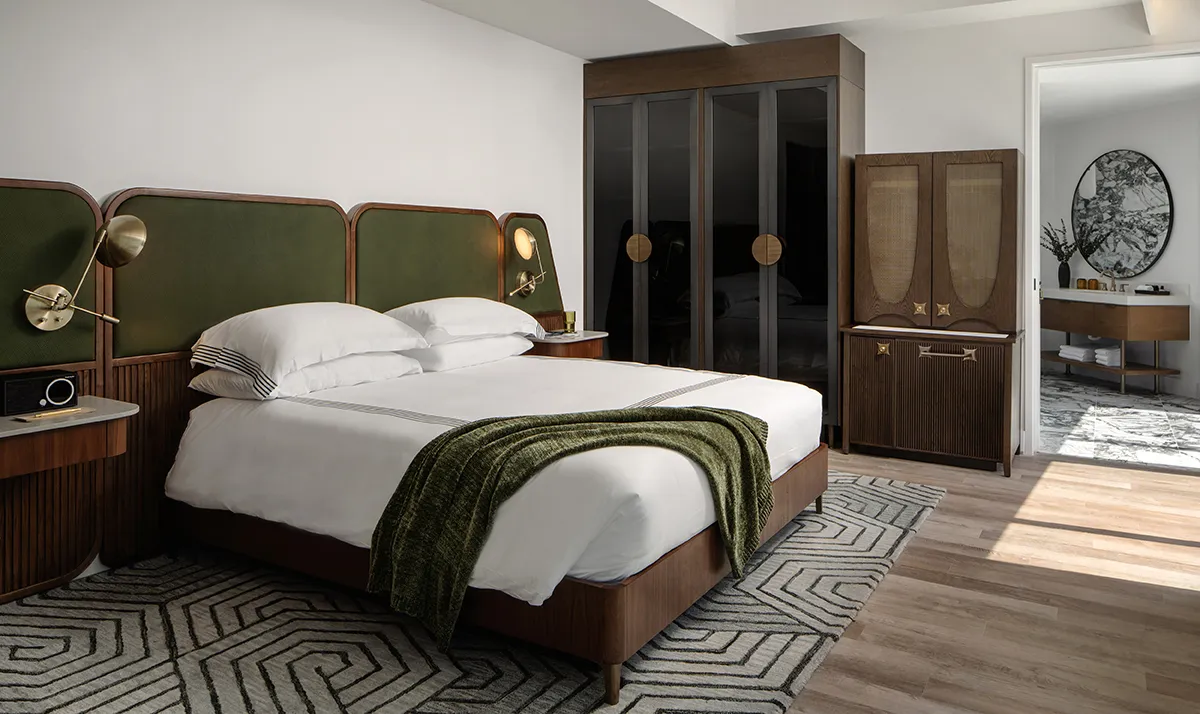
Balancing Aesthetics and Utility in Multifunctional Hospitality Furniture
Balancing Aesthetics and Utility in Multifunctional Hospitality Furniture
Hospitality furniture must balance form and function and be as practical as it is beautiful. With limited guestroom space, multifunctional furniture offers versatile solutions that satisfy travelers’ diverse needs.
An elegantly designed room invites guests in, but its function dictates the quality of their stay. If they can store their belongings, charge their electronics, and comfortably enjoy the space, they will have a memorable and positive experience.
Trends in Multifunctional Hospitality Furniture
Designers find many innovative ways to integrate smart storage or multiple uses into luxury hotel furniture. For example, a striking headboard can be the focal point of a room’s design. Today, they can integrate lighting, shelves, and charging stations. While this bedside convenience makes guests’ stay more effortless and enjoyable, it cannot be at the expense of visual appeal.
Similarly, nightstands are no longer about holding lamps and hotel phones. Modern nightstands can be built into the headboard to maximize floor space or include an integrated charging station for guest convenience.
Pieces that fulfill two or more functions are a great way to combine elegance with practicality. Examples include:
- Stylish ottomans can double as storage benches.
- TV stands that double as desks, combining work and entertainment in one sleek design.
- Beds with built-in drawers offer extra storage without occupying additional floor space.
- Accent chairs with storage or removable table.
- Sectional sofas that can be rearranged to fit the guests’ needs.
- Nesting tables that tuck away when they are not needed provide flexibility.
Material Selection Makes the Difference
When constructing luxury hotel furniture, the selection of materials is critical to the piece’s visual impact, function, and longevity. It’s one thing to craft a design; it’s another thing entirely to flawlessly execute a designer’s vision while producing a piece of furniture that can withstand the rigors of a busy hotel.
Here are several factors that contribute to proper material selection.
Visual Impact
The grain and stain of the wood veneer, the shine of the metal, and the color and texture of the fabric are the first things that catch the eye. They set the tone for the room and make a statement about the hotel’s brand and style.
For example, rich, dark woods like mahogany or walnut exude sophistication, while lighter woods like oak or birch can create a more modern, airy feel. Velvet might be chosen for its lush, opulent texture, while linen delivers a crisp, clean look.
The Location of the Hotel
The functionality of hospitality furniture is as essential as its appearance. The materials must be durable enough to withstand constant use in a busy hotel environment. However, the location of the hotel has a significant impact on which materials are most suitable.
Materials that stand up well to cold may warp or deteriorate in more humid, tropical climates. For instance, certain woods ideal for colder, drier environments might not fare as well in areas with high humidity or salt air.
In coastal areas, for example, metals used in furniture frames or accents should be treated or coated to prevent rust, while woods should be sealed or chosen for their natural resistance to moisture and decay. In sunnier climates, materials resistant to UV radiation are essential to prevent fading and sun damage.
Upholstery choices also vary depending on location. In warmer climates, breathable fabrics like cotton or linen can be comfortable, while in cooler regions, denser, warmer materials might be more appropriate.
Comfort and Experience
The choice of materials impacts guest’s comfort and overall experience. A leather or faux leather chair adds a touch of luxury while providing a cool, smooth surface that can be soothing. Plush, soft fabric on a sofa invites guests to relax and feel at home.
The materials must deliver comfort in addition to creating a visual impact, offering durability, and being suitable for the hotel’s climate.
Sustainability
Material choice can also reflect a commitment to sustainability. Using responsibly sourced wood, recycled materials, or eco-friendly fabrics reduces the environmental impact and can appeal to guests who value sustainability. Over the past few years, Mittman has consistently worked toward decreasing our environmental impact. 2023 was the first year we received MindClick’s highest rating for sustainability in manufacturing.
Crafting Quality Hospitality Furniture
Executing a designer’s vision to perfectly balance aesthetic appeal, durability, comfort, and suitability to a hotel’s location requires expertise that only comes with years of experience and a deep understanding of the craft. At Mittman, we bring over eight decades of experience in the luxury furniture industry, a legacy that speaks to our ability to meet complex demands with precision and mastery.
To discuss the best materials to achieve beauty, durability, functionality, and comfort in your next project, connect with our expert team today.
